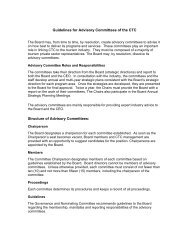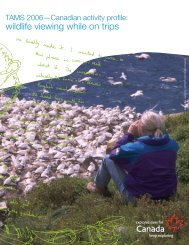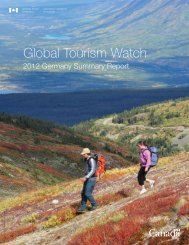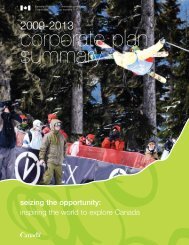Canadian Soft Outdoor Adventure Enthusiasts - Canadian Tourism ...
Canadian Soft Outdoor Adventure Enthusiasts - Canadian Tourism ...
Canadian Soft Outdoor Adventure Enthusiasts - Canadian Tourism ...
Create successful ePaper yourself
Turn your PDF publications into a flip-book with our unique Google optimized e-Paper software.
4.4 Demographic Changes in the <strong>Canadian</strong> Market<br />
Changes to the demographic profile of <strong>Canadian</strong>s over time are apt to have an especially dramatic<br />
impact on Canada’s tourism volume and value, and the types of activities the domestic market will<br />
seek on its travels.<br />
4.4.1 Gender & Age<br />
There will be a noticeable decline in the proportion of the population that is young or middle-aged,<br />
and a substantive increase in the proportion that is older.<br />
• The 18 to 34 year old age group will decline from 1-in-3 to 1-in-4 adult <strong>Canadian</strong>s by 2026;<br />
• <strong>Canadian</strong>s in their “family” years (35 – 44) will fall from over 1-in-5 members of the adult<br />
population to about 1-in-6;<br />
• Middle-aged <strong>Canadian</strong>s (45 – 54) will come close to holding steady as a proportion of the total<br />
population, from 18 per cent in 2000 to 16 per cent in 2026;<br />
• Starting at about age 55, the pattern shifts with older people representing higher proportions of<br />
Canada’s adult population in 2026 than they do now. The increase is most prominent among<br />
<strong>Canadian</strong>s 65 years of age or older. This older group currently represents about one-sixth of the<br />
adult population but by 2026 it is expected to represent over one-quarter.<br />
• In absolute numbers, the young adult population (18 – 34 years) will shift from 7,252,000 to<br />
7,286,000 between 2000 and 2026. This young cohort is growing at a rate that is 98 per cent<br />
lower than would have been expected if the structure of the population had remained constant<br />
between 2000 and 2026. Thus, the impact of changes in the population mix in Canada will<br />
reduce the growth rate of the younger age segment substantively. A similar finding is evident for<br />
other younger and middle-aged cohorts. In the case of the “family market”, not only is the<br />
growth rate much lower than would be expected based on today’s population structure, but there<br />
will be a decrease in the absolute numbers of <strong>Canadian</strong>s in the 35 to 44 year age bracket – from<br />
5,313,000 in 2000 to 4,960,000 in 2026.<br />
Table 18: <strong>Canadian</strong> Adult Population – Age & Gender<br />
% OF ADULT<br />
POPULATION IN . . .<br />
2000 2026<br />
Adults 18+ 23.3 million 29.6 million<br />
GROWTH RATE<br />
FROM<br />
2000 TO 2026<br />
IMPACT OF 2026<br />
POPULATION STRUCTURE<br />
ON GROWTH RATE<br />
Men 49% 49% 27% 1%<br />
Women 51% 51% 27% -1%<br />
18 - 34 years 31% 25% 0.47% -98%<br />
35 - 44 years 23% 17% -7% -124%<br />
45 - 54 years 18% 16% 11% -61%<br />
55 - 64 years 12% 16% 77% 184%<br />
65+ years 16% 26% 111% 309%<br />
Source: Special TAMS Canada Tabulations, Table 1.<br />
28 <strong>Canadian</strong> <strong>Soft</strong> <strong>Outdoor</strong> <strong>Adventure</strong> <strong>Enthusiasts</strong> –<br />
A Special Analysis of the Travel Activities and Motivation Survey (TAMS)
















